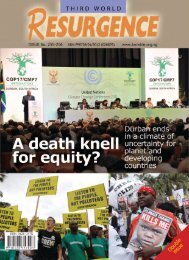Plantations, poverty and power - Critical Information Collective
Plantations, poverty and power - Critical Information Collective
Plantations, poverty and power - Critical Information Collective
You also want an ePaper? Increase the reach of your titles
YUMPU automatically turns print PDFs into web optimized ePapers that Google loves.
26<br />
supposed to reduce greenhouse gas emissions. Botnia hired two consulting firms: Carbosur from<br />
Uruguay, <strong>and</strong> Finl<strong>and</strong>’s Pöyry to investigate the possibilities of gaining financing through the CDM.<br />
Botnia’s CDM project involves burning black liquor from the pulping process to generate electricity. The<br />
pulp mill generates more electricity than it needs, <strong>and</strong> sells surplus electricity to the public electricity<br />
network in Uruguay. Botnia thus claims to be reducing emissions in Uruguay. In addition to selling<br />
electricity, Botnia will sell carbon credits. But to qualify for the CDM, a project must be able to prove<br />
that it is “additional”. That is, it must prove that carbon credits are not being granted to a project that<br />
would have been carried out anyway – without carbon financing. In fact, Botnia’s CEO Erkki Varis said<br />
in 2005, “I expect the factory to be very competitive, with estimated production costs of about half of<br />
those of modern Finnish pulp factories.” 95 There is no evidence to show that Botnia would not have used<br />
waste products from the pulping process to produce electricity if it were not financed through the CDM.<br />
The CDM is simply a way for Botnia to increase its profits.<br />
Oji Paper hopes to get financing for its plantations in Laos through the Clean Development Mechanism.<br />
To do so, it will have to convince CDM’s board that it is planting on “degraded l<strong>and</strong>” <strong>and</strong> that it is not<br />
clearing forest in order to establish its plantations. But researchers in Laos have documented that Oji<br />
Paper has in fact cleared forest, including large trees, to make way for its plantations. It is also planting on<br />
villagers’ l<strong>and</strong>, currently being used for swidden agriculture or cattle grazing. 96 Oji Paper will also have<br />
to convince the CDM’s board that the project is “additional”. Since Oji Paper started planting trees in<br />
Laos in 2004, <strong>and</strong> the area of plantations has exp<strong>and</strong>ed each year since then, arguing that the project is<br />
“additional” <strong>and</strong> could only go ahead with carbon financing, would simply be a lie. 97<br />
By selling carbon credits from plantation projects <strong>and</strong> pulp mills, the industry is not addressing climate<br />
change. Even if we assume that the project is genuinely additional <strong>and</strong> would not have taken place<br />
without CDM financing, the net result is not a reduction in emissions. The CDM is in fact making things<br />
worse by allowing emissions of greenhouse gases to continue.<br />
No more subsidies!<br />
The generous subsidies h<strong>and</strong>ed out to the pulp <strong>and</strong> paper industry raises the question of why industrial<br />
tree plantations are established in the South <strong>and</strong> for whose benefit. In 1993, Ricardo Carrere wrote that<br />
“The economic convenience of tree crops for Third World countries must be questioned. Despite the<br />
obvious contradiction in a world ruled by the neo-liberal ideology, tree plantations are being subsidised in<br />
a number of countries with support from a wide range of agencies, including the World Bank.<br />
“The question is why If investment in plantations were great business, subsidies would not be necessary.<br />
The answer lies in the industrialised countries’ wish to secure the supply of this raw material at the lowest<br />
95 “Uruguay: The Botnia pulp mill project intends to profit from climate change”, World Rainforest Movement Bulletin no.<br />
109, August 2006. http://www.wrm.org.uy/bulletin/109/Uruguay.html<br />
96 Keith Barney (2007) “Power, Progress <strong>and</strong> Impoverishment: <strong>Plantations</strong>, Hydro<strong>power</strong>, Ecological Change <strong>and</strong> Community<br />
Transformation in Hinboun District, Lao PDR. A Field Report”, Probe International, York Centre for Asian Research,<br />
Centre for International Forestry Research, Rights <strong>and</strong> Resources Initiative, YCAR Paper No. 1, June 2007.<br />
http://www.probeinternational.org/catalog/pdfs/Power_Progress_<strong>and</strong>_Impoverishment_Barney.2007.pdf<br />
97 Chris Lang (2006) “Laos: Indian <strong>and</strong> Japanese pulp giants move in”, World Rainforest Movement Bulletin no. 104, March<br />
2006. http://chrislang.org/2006/03/25/laos-indian-<strong>and</strong>-japanese-pulp-giants-move-in/















